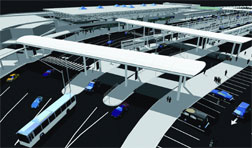 Turne Turner Construction is nearing completion of a roadway project at Oakland International Airport.
|
...has changed the outlook of tolling dramatically. The majority of highways costing more than $500 million will be toll roads,” says Duvall. “Borrowing against user fees will let new projects be built much more rapidly and will encourage more creative design and delivery,” he says.
DOT also strongly supports private-equity options, says Duvall. “There is up to $100 billion in equity available for investment in America's infrastructure. If we can align the interests of the people with the interests of private investors, you can develop them in a successful way,” he says. Duvall also points out that most other infrastructure has been built through private equity with governmental regulation.
The department is also trying to shorten project delivery schedules. “We just put out a new rule on design-build allowing design-build agreements to be negotiated before the environmental impact statement is finished,” says Duvall. “We feel the environmental process can be integrated more efficiently.”
Rosy Picture
The growth potential for the transit market looks bright, provided a solution for funding issues can be identified. “Everyone is looking at mass transit. The question is how to fund the rail projects,” says Brigham of WGI. Most projects require federal subsidies and transportation coffers are simply not deep enough, especially with the high cost of construction in urban areas. In northern Virginia, the Metropolitan Washington Airport Authority is assisting the financing of the expansion of the Metro towards Dulles Airport because the state could not afford the project even with a federal subsidy. Currently, a joint venture between Bechtel and WGI holds the public-private-partnership contract for the $4-billion program, but the project is facing yet another hurdle: The Federal Transit Administration decided that $250 million needs to be cut from the budget before it will provide $900 million of federal funds.
WGI also holds a $77-million project development contract to handle Phase 1 of the Houston Metro expansion. The $1-billion-plus project will feature group rapid transit (GRT) that may be built for bus rapid transit (BRT) initially and converted to light rail as ridership increases and as funds become available. Brigham sees BRT as an option that more cities will consider as a cheaper but still effective option.
Meanwhile, the airport construction market is vibrant, says Jayne O’Donnell, vice president of aviation for Turner Construction, New York City. After the doldrums of the first half of the decade, expanding air traffic has pushed plans off of the drawing boards and into the construction phase. McGraw-Hill Construction Research and Analytics, like ENR part of McGraw-Hill Cos., is projecting $2.7 billion of airport building construction this year, with 10% to 20% more in roadway and airfield work, nearly twice the $1.4 billion of work in 2006. “The West Coast is the most active region, partly because of the aggressiveness of the airlines and partly because the development programs had fallen behind for so long,” says O’Donnell.
Megaprojects now abound. Sacramento is bidding an $830- million contract to build a new terminal. And Los Angeles has selected a preferred alternative for reconfiguration of LAX, including replacing a terminal, removing some parking structures, realigning runways and extending light rail to the airport. The airport hopes to finish the program by 2015 at a cost of $11 billion. The first major contract, for $1.2 billion to build a new international terminal, was authorized on Aug. 15.
San Jose on Aug. 15 authorized an $825-million bond to help pay for a $1.3-billion program to renovate Terminal A, build a new terminal and remove the old Terminal C.
Most of these contracts will be either design-build or construction management-at-risk, says O’Donnell. “Most of the airports only want to deal with one person,” she says. The shift in contracting methods has bred a unique atmosphere of collaboration. “Owners are now asking us our opinions and our needs. They reach out before they put a contract on the street to see what the contractors need to be able to participate,” she says.

Post a comment to this article
Report Abusive Comment